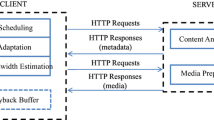Abstract
In the paper, we try to find a method that can service more users in a video-on-demand (VoD) system, based on MPEG-4 object streams. The characteristics of object segmentation made on MPEG-4 videos can be utilized to reduce re-transmission of the same objects, and then the saved bandwidth can be used to service more users. However, some thresholds must be analyzed first to maintain the acceptable quality of services (QoS) requested by users, when reducing unnecessary object transmission on one side. Thus, according to the defined thresholds, we propose a dynamically adjusting algorithm to coordinate the object streams between the server and clients. The server not only allocates network bandwidth, but also adjusts ever-allocated QoS appropriately using a degrading and upgrading strategy, based on the current network status. Lastly, through the simulation, we found that our method has better performance than the other three methods owing to its flexibility to the network status.
Similar content being viewed by others
References
Abbasi S, Mokhtarian F (2001) Affine-similar shape retrieval: application to multiview 3-D object recognition. IEEE Trans Image Process 10(1):131–139
Ahmed T, Mehaoua A, Lecuire V (2003) Streaming MPEG-4 audio visual objects using TCP-friendly rate control and unequal error protection. In: Proceedings of the 2003 International Conference on Multimedia and Expo, vol 1. IEEE Computer Society, Washington, DC, pp 317–320
Brady N (1999) MPEG-4 standardized methods for the compression of arbitrarily shaped video objects. IEEE Trans Circuits Syst Video Technol 9(8):1170–1189
Chen M, Wei G, Zhu X (2003) An IP DiffServ framework for real-time video transmission. In: Proceedings of the IEEE International Conference on Communication Technology. IEEE, Piscataway, pp 1723–1726
Chien S-Y, Ma S-Y, Chen L-G (2002) Efficient moving object segmentation algorithm using background registration technique. IEEE Trans Circuits Syst Video Technol 12(7):577–586
Furini M, Towsley DF (2001) Real-time traffic transmissions over the Internet. IEEE Trans Multimedia 3(1):33–40
Goto H, Aso H (2000) Character pattern extraction based on local multilevel thresholding and region growing. Proceedings of the 15th IEEE International Conference on Pattern Recognition, Barcelona, pp 430–433
Kim S, Kim Y, Yim K, Chung H, Choi K, Kim Y, Jung G (1997) A fast motion estimator for real-time system. IEEE Trans Consum Electron 43(1):24–33
Kung H-Y, Liu Y-Y, Chen C-Y, Lin M-H (2005) A differentiated object priority control mechanism for MPEG-4 streaming. Proceedings of the IEEE International Conference on Consumer Electronics. IEEE, Piscataway, pp 373–374
Kwon JB, Yeom HY (2002) Providing VCR functionality in staggered video broadcasting. IEEE Trans Consum Electron 48(1):41–48
Lin C-W, Zhou J, Youn J, Sun M-T (2001) MPEG video streaming with VCR-functionality. IEEE Trans Circuits Syst Video Technol 11(3):415–425
Liu S, Kuo CCJ (2003) Joint temporal-spatial rate control for adaptive video transcoding. In: Proceedings of the 2003 International Conference on Multimedia and Expo, vol 1. IEEE Computer Society, Washington, DC, pp 225–228
Lotfallah OA, Panchanathan S (2003) Adaptive scheme for Internet video transmission. Proceedings of the IEEE International Symposium on Circuits and Systems. IEEE, Piscataway, pp 872–875
Lu M-T, Lin C-K, Yao J, Chen H (2005) Complexity-aware live streaming system. Proceedings of the IEEE International Conference on Image Processing. IEEE, Piscataway, pp 193–196
Merz M, Froitzheim K, Schulthess P, Wolf H (1997) Iterative transmission of media streams. Proceedings of the 5th ACM International Conference on Multimedia. Seattle, 9–13 November 1997, pp 283–290
MPEG Video Group (1996) MPEG-4 video verification model — version 2.1. ISO/IEC JTC1/SC29/WG11
Sikora T (1997) The MPEG-4 video standard verification model. IEEE Trans Circuits Syst Video Technol 7(1):19–31
Su G-M, Wu M (2005) Efficient bandwidth resource allocation for low-delay multiuser video streaming. IEEE Trans Circuits Syst Video Technol 15(9):1124–1137
Sung WR, Kang EK, Choi JS (1999) Adaptive motion estimation technique for motion compensated interframe interpolation. IEEE Trans Consum Electron 45(3):753–761
Wu D, Hou YT, Zhu W, Zhang Y-Q, Peha JM (2001) Streaming video over the Internet: approaches and directions. IEEE Trans Circuits Syst Video Technol 11(3):282–300
Author information
Authors and Affiliations
Corresponding author
Rights and permissions
About this article
Cite this article
Huang, YF., Chiu, CY. Dynamically adjusting MPEG4 video streams based on network bandwidth. Multimed Tools Appl 36, 267–284 (2008). https://doi.org/10.1007/s11042-007-0146-3
Published:
Issue Date:
DOI: https://doi.org/10.1007/s11042-007-0146-3




